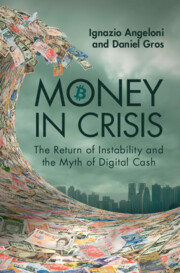Refine search
Actions for selected content:
664 results
12 - Clinical governance
- from Part 3 - Engages Others
-
-
- Book:
- Leading and Managing Health Services
- Published online:
- 15 August 2025
- Print publication:
- 28 August 2025, pp 131-141
-
- Chapter
- Export citation
Assessing the engineering design costs to meet environmental regulations: the case of packaging
-
- Journal:
- Proceedings of the Design Society / Volume 5 / August 2025
- Published online by Cambridge University Press:
- 27 August 2025, pp. 661-670
-
- Article
-
- You have access
- Open access
- HTML
- Export citation
9 - Conclusion
-
- Book:
- Extroverted Financialisation
- Published online:
- 07 August 2025
- Print publication:
- 21 August 2025, pp 162-174
-
- Chapter
- Export citation
2 - Legal and Contractual Aspects of Agency and Player–Agent Relations in Professional Tennis
- from Part 1 - Contractual
-
-
- Book:
- Professional Tennis and Transnational Law
- Published online:
- 07 August 2025
- Print publication:
- 21 August 2025, pp 23-41
-
- Chapter
-
- You have access
- Open access
- HTML
- Export citation
5 - Grounding USDs
-
- Book:
- Extroverted Financialisation
- Published online:
- 07 August 2025
- Print publication:
- 21 August 2025, pp 91-104
-
- Chapter
- Export citation
2 - Progressivism without Experts
- from Part I - The KCIR in Kansas
-
- Book:
- The Kansas Court of Industrial Relations
- Published online:
- 26 July 2025
- Print publication:
- 14 August 2025, pp 35-65
-
- Chapter
- Export citation
On Regulating Downstream AI Developers
-
- Journal:
- European Journal of Risk Regulation , First View
- Published online by Cambridge University Press:
- 04 August 2025, pp. 1-29
-
- Article
-
- You have access
- Open access
- HTML
- Export citation
4 - The Second Bridge
-
- Book:
- Disability, Human Rights, and Contract Law
- Published online:
- 06 August 2025
- Print publication:
- 31 July 2025, pp 92-164
-
- Chapter
- Export citation
25 - Innovation Policy and the Press
- from Part VI - Supporting the Press Function
-
-
- Book:
- The Future of Press Freedom
- Published online:
- 25 July 2025
- Print publication:
- 24 July 2025, pp 437-465
-
- Chapter
-
- You have access
- Open access
- HTML
- Export citation
Regulating human identical milk oligosaccharides in infant formula products
-
- Journal:
- Proceedings of the Nutrition Society / Volume 84 / Issue OCE2 / June 2025
- Published online by Cambridge University Press:
- 24 July 2025, E186
-
- Article
-
- You have access
- Export citation

Money In Crisis
- The Return of Instability and the Myth of Digital Cash
-
- Published online:
- 15 July 2025
- Print publication:
- 12 June 2025
Scientists’ Coalition perspectives on articles of the Chair’s text
- Part of
-
- Journal:
- Cambridge Prisms: Plastics / Volume 3 / 2025
- Published online by Cambridge University Press:
- 10 July 2025, e24
-
- Article
-
- You have access
- Open access
- HTML
- Export citation
The Interaction between the Competition Council and the Telecommunications Regulatory Authority in Algerian Law
-
- Journal:
- Journal of African Law , First View
- Published online by Cambridge University Press:
- 07 July 2025, pp. 1-14
-
- Article
-
- You have access
- Open access
- HTML
- Export citation
Chapter 12 - On the Meaningfulness of Disturbance
- from Part IV - Meaning and Disturbance
-
- Book:
- The Development and Organization of Meaning
- Published online:
- 11 June 2025
- Print publication:
- 26 June 2025, pp 157-174
-
- Chapter
- Export citation
7 - Captains of Industry
-
- Book:
- The CEO
- Published online:
- 19 June 2025
- Print publication:
- 19 June 2025, pp 216-238
-
- Chapter
- Export citation
Comparing the Draft and Final Circular A-4
-
- Journal:
- Journal of Benefit-Cost Analysis , First View
- Published online by Cambridge University Press:
- 19 June 2025, pp. 1-11
-
- Article
-
- You have access
- Open access
- HTML
- Export citation
Be Brief, Be Consistent, Be Neutral: Comments on US Draft Circular A-4, “Regulatory Analysis”
-
- Journal:
- Journal of Benefit-Cost Analysis , First View
- Published online by Cambridge University Press:
- 13 June 2025, pp. 1-13
-
- Article
-
- You have access
- Open access
- HTML
- Export citation
4 - Demobilizing Migrant Workers
- from Part I - Public Services as Social Control
-
- Book:
- Beyond Coercion
- Published online:
- 10 June 2025
- Print publication:
- 12 June 2025, pp 73-98
-
- Chapter
- Export citation
14 - Money in Crisis and the Possible Future
-
- Book:
- Money In Crisis
- Published online:
- 15 July 2025
- Print publication:
- 12 June 2025, pp 353-361
-
- Chapter
- Export citation
Is Assisted Dying Really a Matter for Medical Regulation?
-
- Journal:
- Journal of Law, Medicine & Ethics / Volume 53 / Issue 2 / Summer 2025
- Published online by Cambridge University Press:
- 28 May 2025, pp. 267-278
- Print publication:
- Summer 2025
-
- Article
-
- You have access
- Open access
- HTML
- Export citation
